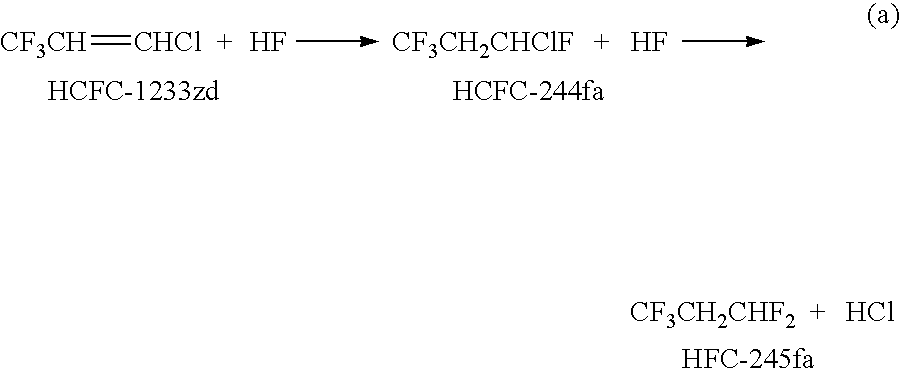Process for the manufacture of 1,3,3,3-tetrafluoropropene
a technology of tetrafluoropropene and tetrafluoropropene, which is applied in the preparation of halogenated hydrocarbons, physical/chemical process catalysts, hydrogen halide split-off, etc., can solve the problems of not being economical relative to the product yield of known processes, and certain chlorofluorocarbons might be detrimental to the earth's ozone layer
- Summary
- Abstract
- Description
- Claims
- Application Information
AI Technical Summary
Problems solved by technology
Method used
Image
Examples
examples 1-18
[0026]A fluorination reaction was conducted in a 2.54 cm diameter, 81 cm long Monel® reactor. The reactor was heated with an electric furnace. The reactants of HCFC-1233zd (>99.9% purity), anhydrous HF and, optionally, chlorine, were fed to the reactor at constant flow rates. The flow rate of the chlorine was measured using a Hasting mass flow meter and controller. The flow rate for the reactants, HCFC-1233zd and HF, were controlled and measured by Honeywell PlantScape DCS (Distributive Control System) and confirmed by the weight change in the respective source cylinders.
[0027]The reactor output was sampled directly into an in-line GC, i.e. a Perkin Elmer 8500 gas chromatograph, using a Fluorocol column and FID detector, so that the amounts of organic species exiting the reactor could be determined during the operation of the process.
[0028]The reaction conditions for Examples 1-18 and corresponding experimental results are listed below in Tables 1 and 2, respectively. Contact time i...
example 19
[0035]This example illustrates the continuous vapor phase dehydrochlorination reaction of 1-chloro-1,3,3,3-tetrafluoropropane (HCFC-244fa)→1,3,3,3-tetrafluoropropene (HFO-1234ze)+HCl. The dehydrochlorination catalyst for the experiment is 10 wt % CsCl / 90 wt % MgF2.
[0036]Conversion of HCFC-244fa into HFO-1234ze is performed using a Monel reactor (ID 2 inches, length 32 inches) equipped with a Monel preheater (ID 1 inch, length 32 inches) which is filled with Nickel mesh to enhance heat transfer. The reactor is filled with 2.0 liters of pelletized 10 wt % CsCl / 90 wt % MgF2 dehydrochlorination catalyst. Nickel mesh is placed at the top and at the bottom of reactor to support the catalyst. A multi-point thermocouple is inserted at the center of the reactor to monitor the catalyst bed temperature. The catalyst is pretreated in dry N2 flow for 6 hours at the temperature of 480° C. Then the feed with the composition 98.0 GC % HCFC-244bb / 0.9 GC % HCFO-1233zd / 1.1 GC % HFC-245fa is introduced...
example 20
[0037]In a typical experiment, a 2.54 cm×81 cm Monel® reactor is used. About 500 ml of catalyst supported on activated carbon is packed into the reactor. The reactor is heated to 150° C. under 1 liter / hr of nitrogen flow to dry the catalyst for 4 hours. Then, the reactor temperature is brought to 250° C. under the same nitrogen flow and HCFC-244fa is fed to the reactor at 1 g / min, and in the mean time the nitrogen flow is stopped. HFO-1234ze is found by using the in-line GC at the outlet of the reactor at 98% selectivity and 95% single pass conversion.
PUM
| Property | Measurement | Unit |
|---|---|---|
| Temperature | aaaaa | aaaaa |
| Temperature | aaaaa | aaaaa |
| Temperature | aaaaa | aaaaa |
Abstract
Description
Claims
Application Information
 Login to View More
Login to View More - R&D
- Intellectual Property
- Life Sciences
- Materials
- Tech Scout
- Unparalleled Data Quality
- Higher Quality Content
- 60% Fewer Hallucinations
Browse by: Latest US Patents, China's latest patents, Technical Efficacy Thesaurus, Application Domain, Technology Topic, Popular Technical Reports.
© 2025 PatSnap. All rights reserved.Legal|Privacy policy|Modern Slavery Act Transparency Statement|Sitemap|About US| Contact US: help@patsnap.com

